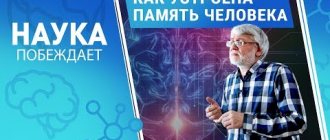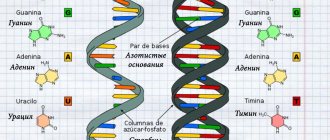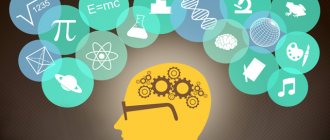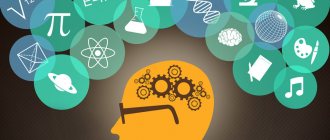Not many people think about what genetic memory is and what it stores in itself.
Even fewer people are even aware of its presence in the subconscious. Let's see what is meant by the term “human genetic memory.” Turning to science for answers, you can find a definition that human genetic memory is a memory (experience, memories) that stores all the information that was once stored by previous carriers. This is information that could be passed on from generation to generation in a person’s family and manifest itself in the form of unclear images. Genetic memory can also be understood as the ability of a person’s subconscious to save data that could not be acquired by the individual during his life.
The essence of the problemedit
So what do genes give us?
A lot really depends on them - body type, predisposition and immunity to diseases, eye color, innate strength, reaction, vision, and the like. In general, one person is born a hero, another suffers from weakness, one girl can eat tons of hamburgers and not gain any weight, another can count calories all her life and sweat in the gym (however, there is an opinion that she counts calories and then cries because that in principle he cannot resist eating the cake), one word - genes. What does training give us? Much. Mind training, of course, is unlikely to make a person a genius, but without it, erudition and the ability to process information will not be able to develop (tested on Mowgli children), and the brain will not be able to respond to a threat quickly (if only because a trained military man can at first glance, recognize a threat, even without seeing it, assume its presence and direction, where to expect it from; and a civilian, if he hasn’t watched a lot of militants, which is also experience, will point his finger at the bomb, having no idea what it is and why it’s ticking ). Without a course of physical training, even if a person has a genetic predisposition to be strong and dexterous, these qualities will not be able to manifest themselves properly - the body, of course, is strong, but it will not be able to use strength without injuring itself. Rarely experiencing pain, you will not learn to endure it, and without practicing shooting, you will not become either a sniper or an expert in firing from the hip in Macedonian style right at the target.
Thus, initially the specialists were ordinary people who had gone through school, university, basic combat training, junior commander courses and were covered with scars from numerous practice in combat conditions, then they tried to upgrade them to the heights of the potential inherent in the genome, and when it turned out that without training, they are brutally raked from simple but trained ones, the authors began to think about what to do next. Well, of course, you need to integrate knowledge and experience into the firmware, and then quickly implement it - but how? There are two ways: either directly into the genome, or stitched into the brain using a hypnotic device. Both are impossible from the point of view of reality (yet).
Related concepts[edit]
- A simple cool mortal is an ordinary person who trained and studied for a long time to become an unsurpassed specialist and simply cool
. For example, Batman. - People-plus are a person who has developed to the heights of the potential inherent in the genome. Also studied and trained to become tough. For example, Captain America or ordinary earthlings in the World of Noon.
- Mutants are people whose genome carries some fundamental change. Even without training, they have innate special abilities (or even several). For example, Spider-Man has the ability to climb walls.
- Cyborgs are people who have been upgraded with mechanics and/or electronics. Able to learn new skills and knowledge through a direct connection to the network. Example - RoboCop, Motoko Kusanagi
- Trans people are people whose genome has been subjected to systematic, thorough enhancement. An example is the Cetagandan outs.
- Post-humans are a person modified so much that it is difficult to consider him just a person. An example is the people of the future in Babylon 5, who have a body made of pure energy, hide their essence in a spacesuit (and generally look like Vorlons) and can perform various powerful sorceries.
The mechanism of manifestation of memories from past lives
Each of us experienced a feeling of deja vu. It appears completely unexpectedly and looks like confidence that you have already experienced the current moment before, have seen what you see now and have been in a place where you have never actually been.
Many scientists are skeptical about the theory of rebirth and explain déjà vu as something read in a book, seen in a movie, or invented while reading a book.
At the same time, there are moments when deja vu causes an avalanche of memories of a past life. This happened to a friend of mine who was cutting lemon for tea. When the tea was ready, and Ilya settled down with a mug in front of the TV and took a sip of the aromatic drink, he simply choked on the sudden flood of memories.
American psychologist Frederick Lenz studied similar cases for several years. The result of his research was the book “Times of Life,” in which he described all his observations. According to Dr. Lenz, memories of past lives visit a person during meditation, in dreams and during déjà vu.
In addition, the specialist noticed that many of those who experienced this noted changes in their physical and mental state. These changes manifested themselves in the form of euphoria, a feeling that the whole world around was becoming brighter and seemed to vibrate slightly. After such a shock, people who remembered a piece of a previously lived life spent some time in a state of stupor.
Real life[edit]
- In the biosphere of planet Earth, as a rule, the more primitive a creature is, the more it relies on genetic skills inherent from birth, and the less on self-learning. This is despite the fact that the ability to self-learn is itself a “genetic” skill.
| [change] Wonders of Science | ||
| Concepts | The future for the future • Pseudoscience • Science is cool • Cautious science • For the sake of science! • Techno-religion • Fantastic assumption • Fullerene effect | |
| Technologies | GPS • Cryptography • World Wide Web (Darknet) • Gadget • Hydraulics • Eugenics • Foolproof • Cable instead of batteries • Cloning • Space miners • Space elevator • Luminescence • Doomsday machine • Nanomachines • Broken technology • Facial recognition • Power armor • System life support • Smartphone • Shooting elementary particles • Truth serum • Telepathic interface • Terraforming • Fusion reactor • Transformer • Cycler • Miracles from science | |
| Bananotechnology | Paranormal Research Agency • E=const vs. Inexhaustible source of energy • Anti-gravity vs Artificial gravity • Combat centipede • Blaster • Aircraft carrier • Fictional substances (Pandemonium chloride • Horseradish) • Hyperlink • Light bulb eyes • Jetpack • Star fighter • Green stones • Internet from a flying saucer • Use your brain at 100% • Space Megagun • Robot Blood and Robot Language • Flying technology and/or vehicles (car • board • motorcycle • submarine • saucer • tank) • Death Ray (Disintegrator) • Magical pseudoscience • Mathematics • Time machine • Brain in a jar • Monomolecular thread • Not electricity • Neutron megaloplasm • Neonka • An incomprehensible contraption • Research Institute of Magic • Ornithopter/Macholet • A discovery that will turn the whole world upside down • Organic computer • Patented tool • Sacred machine • Superscience (ancient • alien (non-human technology) • Nazi vs Soviet) • Force field (cracked) • Stasis field • Super-GROWTH • Secret research • Hard light • Technogenic mess • Technology for obtaining superpowers • Technomagic • Tiryampampation (Hyperdrive) • Transformer • Outdated scientific theories • Phlebotinum (Imported alien phlebotinum • Fashionable phlebotinum • Applied Phlebotinum • Misapplied Phlebotinum) • Tinfoil Hat • Schizotech • Reality Anchor | |
| Through the eyes of humanists | Exploding monitors • High-tech hexagons • Shoot the monitor • Hollywood acid • Dating on electronics vs The future does not live up to expectations • Iron button press • Green radiation light • Viewer interface • Copying is easy • Red button • Magic database • Cell phone picks up anywhere • Monoxide dihydrogen • Radiation is magic! • Colorful space • Standard unsolved riddles • Lightning strike works wonders • Unique prototype • Good electricity, bad electricity • Noisy space Computer magic: Hollywood hacking (Hacking via Paint • Explosion of a nuclear power plant via Wi-Fi) • Increase button • Computer viruses • Slow money transfer • ... | |
| People of Science | Archaeologist-adventurer • Genius is a magical science • Herr Doktor • Master of all sciences • Unlucky inventor • Nikola Tesla • Unethical scientist • Progressor vs Stagnator • Professor Vibegallo • His own test subject • Scientist (Skystone scientist • Professor Fanservice • Mad scientist • Scientist and officer • Scientist and politician • Scientist and priest • Scientist looks like Einstein • Scholastic scientist) • Renaissance man Non-secret organization | |
| Stereotypical locations | Academy of Sciences • Library • Laboratory | |
| Problems | Anomaly • The gods took away the fire • Big mistake • Science doesn't work • Science is bad • Malignant autonomous technology (Riot of the Machines • Gray Goo) • Extra details • Doesn't happen! • Misuse of Science (Misuse of Patents) • No Preliminary Tests Needed • Technological Singularity • Transhumanism is Bad • Scientist Raped Journalist • Scientist Not Crazy • Phlebotic Rebel | |
| Creatures | Voice Assistant • Laplace's Demon (Omega) • Maxwell's Demon • Schrödinger's Cat • Einstein's Mouse • Boltzmann's Brain • Philosophical Zombie | |
| Pseudoscientific theories (something that doesn’t even look like a banana) | 25th frame • Firmware of coolness • Indigo children • Lenin is a mushroom • Transfer of the soul • Counter-earth | |
Genetic memory in culture
The term is often used in works of art (most often in the literal sense) as well as in other cultural contexts.
One striking example is the works of such authors as Jack London and Robert Howard. Thus, in the work “Interstellar Wanderer,” London describes the reincarnations of the convicted Darrell Standing. London's novel was famously influenced by Robert E. Howard, who wrote many stories on the theme of reincarnation, such as the James Ellison series, Thunderrider.
,
Children of the Night
,
People of Darkness
,
Cairn on the Cape
and many others. In the context of these authors, the theme of reincarnation is closely related to genetic memory, because the heroes of the works and their incarnations are part of the same racial branch.
Genetic memory is described in Ivan Efremov’s story “The Hellenic Secret”, called “memory of generations”, and in the work itself confirmed by the experiments of transpersonal psychology.
The concept plays an important role in the Dune Chronicles series of novels by Frank Herbert (especially the fictional concept of the Kwisatz Haderach).
As a component of the plot, genetic memory is presented in the Assassin's Creed series of computer games and the film based on the game Assassin's Creed. A group of scientists were able to invent the Animus
, capable of extracting from the subject information about ancestors embedded in his genes.
Description
Genetic memory is a hypothetical phenomenon consisting of genotype-based “memory” for biological events that occurred during the evolution of a biological species. The word "memory" is used in a metaphorical sense to denote a genetically encoded propensity for certain behaviors and patterns of action that are the vestiges of evolutionarily important changes in the species. As an example: fear of falling and reflexive reactions to falling objects are examples that reflect the evolutionary adaptive response that any successfully developing primate species with a high body mass-to-surface ratio must have.
Genetic memory considers a number of behavioral acts inherent in animals and humans, mostly in the early age category. Genetic memory allows a newborn to preserve his life until he accumulates sufficient experience. The carriers of gene memory are nucleic acids, united in chromosomes and genes that facilitate the storage and accumulation of information. Includes unconscious actions, whether unconditioned reflexes or a set of fixed actions. Genetic memory is characteristic of all species of animals and in newborns is of primary importance in relation to phonetic memory - memory based on individually acquired experience and learning. As a consequence, phonetic memory is responsible for newly acquired information and experience, which is used in further generations by genetic memory.
In the modern interpretation, languages are considered as part of genetic memory. The fact that humans can have languages is a property of the nervous system that is present at birth, and is thus phylogenetic. At the same time, the perception of a set of phonemes is characteristic of adverbs formed through ontogenesis. In fact, there is no genetic predisposition to any one language. For example, children of a particular region are not genetically predisposed to speaking local languages. This refutes the relevance of gene memory to Lamarckism.
According to Jung's theory, in relation to humans, genetic memory is the collective unconscious. This is the experience of human ancestors, represented by the nervous structures of the brain. Carl Jung also attributed some mystical elements (connotations) to the term.
Notes
- Dictionary of a practical psychologist. — M.: AST, Harvest. S. Yu. Golovin. 1998.
- Explanatory dictionary of psychology. 2013.
- Trainer's Dictionary. V. V. Gritsenko.
- Rodolfo R. Llinas (2001). I of the Vortex: From Neurons to Self. MIT Press. pp. 190-191. ISBN 0-262-62163-0.
- Encyclopedic dictionary of psychology and pedagogy. 2013.
- Louis D. Matzel (2002). "Learning Mutants". In Harold E. Pashler. Steven's Handbook of Experimental Psychology. John Wiley and Sons. p. 201. ISBN 0-471-65016-1.
- Timothy L. Strickler (1978). Functional Osteology and Myology of the Shoulder in the Chiroptera. Karger Publishers. p. 325. ISBN 3-8055-2645-8.
- Brian Keith Hall, Roy Douglas Pearson, and Gerd B. Müller (2003). Environment, Development, and Evolution: Toward a Synthesis. MIT Press. p. 17. ISBN 0-262-08319-1.
- Robert F. Almeder (1992). Death and Personal Survival: The Evidence for Life After Death. Rowman & Littlefield. pp. 28-29. ISBN 0-8226-3016-8.
- Susan J. Blackmore (1999). The Meme Machine. Oxford University Press. p. 60. ISBN 0-19-286212-X.
- John Donnelly (1994). Language, Metaphysics, and Death. Fordham Univ Press. p. 356. ISBN 0-8232-1562-8.
- Book Nameless Cults, preface to the story Black Eons
Literature
- Psychology and Pedagogy, U/P
, Author - L. N. Strizhak, Publisher - MGIU, ISBN 5-276-01042-0, 9785276010427 - General psychology, Short course
, Author - Robert Semenovich Nemov, Publisher - Peter Publishing House, 2008, ISBN 5-469-00944-0, 9785469009443 - Fundamentals of Psychology: a course of lectures
, Authors - Vyacheslav Andreevich Ivannikov, Ivannikov V A, Publisher - Peter Publishing House, 2013, ISBN 5-498-07757-2, 9785498077574 - Psychology
, Author - Viktor Viktorovich Nikandrov, Publisher - Wolters Kluwer Russia, 2009, ISBN 5-466-00413-8, 9785466004137 - Fundamentals of the physiology of higher nervous activity
, Author - A. B. Kogan, Publisher - Ripol Classic, ISBN 5-458-38352-4, 9785458383523
Myth 1: Genetic memory
Many experts adhere to the principles of the existence of genetic memory for food. This means that it is much healthier for each person to eat foods that grow only in their region. And here we are often offered cucumbers, tomatoes and potatoes. But if you remember, Peter 1 brought these same potatoes to Rus', but the ancient inhabitants did not have cucumbers and tomatoes at all. It turns out that today’s “originally Russian” products were not such 100-200 years ago, and it takes much more time to consolidate our genetic memory.
Opponents of this theory argue that there is no genetic memory at all and it is important to make your diet as varied as possible, using all the products available to you
Scientists' hypotheses about the issue of genetic memory of organs
The father of telegony is Aristotle. He came to the conclusion that an individual’s heredity is influenced not only by his parents, but also by other partners who had sexual intercourse with his mother before pregnancy. In ancient Greek mythology, the son of Odysseus was born in this way, so he was named Telegonus. Telegony also tried to explain the manifestations of traits in offspring that were not inherent in their parents.
Gregor Johann Mendel, who is the abbot of the Starobrno Monastery, began to refute this theory by making a discovery in genetics. He said that a person’s characteristics are passed on from parents to descendants and nothing more.
Academician Lysenko again began to stir up attention to telegony and the memory of the uterus. Genetics was prohibited as it was considered a corrupt phenomenon
However, this science still survived, and now genetics is considered scientifically proven, and telegony is fading into oblivion.
What actually affects the offspring? If we discard the unconfirmed theory about the memory of the uterus, then a number of scientifically based facts remain. Before planning a pregnancy, partners should visit a gynecologist, geneticist and specialized specialists.
It will be necessary to visit a doctor for heredity screening in the following cases:
- in families, spouses have hereditary diseases;
- in case of marriage between close relatives;
- the woman has a history of miscarriages, missed pregnancies, and a diagnosis of infertility;
- if there is one unhealthy child in the family;
- in case of bad influence on parents of factors: radiation, magnetic field, chemicals, use of heavy medications;
- if a woman reaches 35 and a man reaches 40 years old, since at this age the risk of mutations is increased;
- in case of negative Rh in a woman.
A geneticist is drawing up a genealogical chart. If there is a chance of having a child with a disability, the doctor will order a test to determine whether the problem can be cured.
If a woman is already pregnant, but is worried about genetic abnormalities, then she is prescribed prenatal diagnosis. The fetus is examined in utero. In 98% of cases, chromosomal abnormalities are detected, and in 40%, defects in the development of various organs can be found.
So, from all of the above, we can make an unambiguous conclusion that the theory of the genetic memory of the uterus, or telegony, remains a theory. It is not confirmed by anything. It remains interesting only as a stage in the historical development of the science of genetics. The memory of the uterus is a prejudice, since from a scientific point of view, previous partners do not have any effect on the formation of the child. The baby will only have what mom and dad put into him.
Much knowledge - many sorrows?
Every time it comes to introducing and using a diagnostic method in medical practice, it is necessary to evaluate its usefulness. If we start giving genetic tests to patients with mental disorders, will it be beneficial for them? Will we receive any meaningful information for the diagnosis and treatment of this group of diseases?
At the current stage of development of the genetics of mental disorders, their benefit is questionable. Studies with large samples produce too many uncertain and poorly applicable results. The main reason for this is the fundamental difference between mental disorders and monogenic diseases. In the classic case of a monogenic disease (for example, Huntington's disease), it is enough to analyze the structure of one gene to understand whether the patient has this disorder or not. This would work with equal certainty to predict the development of Huntington's disease in a potential carrier of the gene. You can remember Thirteen from the TV series House, who with one test found out whether she would develop Huntington's disease or not [20].
Mental disorders have a different genetic basis. These are polygenic diseases, the development of which is associated with changes in the functioning of many genes simultaneously. Identifying each of these genes will not provide important diagnostic information for the doctor, at least at the current stage of development of this field of knowledge. There is also little point now in predicting the risk of developing a mental disorder based on genetic studies in each individual and relatives of known patients. Environmental factors play an important role in the development of mental disorders—socioeconomic status, serious upheavals in life, and a person’s place of residence. Uncertain information received by a person without a mental disorder will lead to increased anxiety about his health, and this excessive worry can trigger the onset of illness (“I was worried that I would go crazy, and I ended up going crazy”). . Another side to identifying such genetic risks in a person is a negative attitude towards him from others (“He has schizophrenia genes, which means he can become schizophrenic at any moment”). This will significantly complicate a person’s life. Although the risk itself may be insignificant, all the words and decisions a person makes can be perceived through the prism of his potential insanity. A person with a calculated risk of mental disorder may be recognized as ill even without the disease itself. The benefit here is, of course, questionable.
This problem is well illustrated by studies of the 5-HTTLPR (serotonin transporter) gene, which is often associated with the risk of antisocial behavior (aggression, property crimes). A short version of the gene with a small number of repeats in its structure makes a person vulnerable to external manifestations of threatening situations and provokes increased activity of the hypothalamic-pituitary-adrenal system [21]. As a result, an adolescent with a short version of the 5-HTTLPR gene will be more likely to exhibit antisocial behavior than one with a long version of this gene. So far everything is clear: let’s take all teenagers and test them for this gene. Then we will form a risk group and closely monitor it to prevent crimes and these young people from going to prison. As they say, it was smooth on paper, but they forgot about the ravines. The “ravine” in this case is environmental factors, in particular, the socio-economic conditions in which the teenager grows up. If we are talking about disadvantaged areas, then in them the predominant influence on antisocial behavior is exerted by economic and social factors (unemployment, level of education) [22]. This means that to prevent crimes, interventions are needed at the level of the entire locality, measures that improve the social climate as a whole. The influence of 5-HTTLPR gene variants becomes noticeable under favorable socio-economic conditions. It turns out that “genetic” hooligans should be looked for not in slums and ghettos, but among representatives of the middle class and wealthy citizens, which is somewhat discouraging.
The development of genetic research in the field of mental disorders will continue. Thanks to our research, we have data on pharmacogenetics that allows us to wisely select treatment to avoid side effects and achieve a good treatment outcome. Calculating the risk of developing a disease and diagnosing mental disorders still remains a difficult and unattainable task in practice. Let's hope this changes over time.
Facts or myths
Answering the question of whether genetic memory exists, it is enough to give examples that are also relevant for the modern world:
1. The most striking and accessible are the rings of trees, which can be seen on their cuts. Considering that trees retain their “memories” and history in the form of circles year after year, and also that they are similar to the human body in mental and psychological properties, they can be considered an excellent example of the manifestation of genetic memory. By following the memories of ancestors stored in a person’s subconscious, one can trace the historical stages of human development.
We recommend: How to develop memory?
This is confirmed by one of the experiments of the psychic Valery Avdeev. Psychological experience, presented in the form of a show that was once demonstrated by the famous psychic in Novosibirsk, allowed many to realize the importance of gene memory.
Avdeev, having immersed the subject in a state of hypnosis, asked him to return to childhood, and then move on to the period before his conception. Surprisingly, the man on stage began to move, imitating the activities of a peasant from the last century. After some time, Avdeev asked a person in a hypnotic state to “dive” even deeper into his subconscious and show what happened to him in prehistoric times. A man under hypnosis, dropping to all fours, reproduced the stance of a wolf, while howling very realistically.
It turns out that genetic memory not only exists, it represents countless memories that are inherent in every person. Of course, this example is not irrefutable evidence, and the choice whether to believe such experiments remains with each of us.
2. Another proof of the existence of gene memory is the experiment with honey. Surprisingly, this product can also have its own memories. If you drop some honey on a saucer and then add a drop of spring water to it, dissolving it will reveal an unusual pattern of perfectly smooth and identical hexagons on the surface. Such a picture will be very reminiscent of the honeycombs in a hive with their exact location. Consequently, even food products are capable of storing encoded information.
Techniques for restoring ancestral memory
The simplest method of unity with clan and family is care and blessing. You can ask for blessings from your parents, grandparents, and bless your children.
We must not forget about our loved ones. It is important to do good for them in all possible situations. Can you find out the history of your great-grandparents? What is known about them? At school everyone studies world history, but does anyone know how my great-great-grandmother lived? Who was she? It would be nice to find out how possible this is.
There are also special techniques. One of them involves restoring connections with family:
- Close your eyes and imagine your mother and father alternately. Note who is in what place. If someone is standing behind, mentally you need to put him a step forward. It is important to feel the same expression of love for both.
- Ask your parents for forgiveness for the trouble they caused. This will allow you to let go of the past.
- Thank your parents for life.
- You need to start doing good deeds towards them.
The memory of ancestors becomes accessible under conditions of hypnosis and meditation. If a hypnosis session involves the participation of a person trained for this, then you can learn to meditate. There are many ready-made audio files and training videos on the Internet. If you wish, you can also learn self-hypnosis.
It’s paradoxical, but true: the modern world takes away our main values, but provides enormous opportunities for their reacquisition. Ancestral memory is no exception. Patience and determination will help on the path to restoring connections with your family.
What is the reason for the formation of a honeycomb pattern on the surface of honey? Why does this happen?
It is important to remember that the honeycomb pattern is not formed due to the presence of any biological or genetic memory. The theory only causes bewilderment among most scientists, since the phenomenon has long been studied
Bénard cells still affect every viscous fluid.
Biological memory is a method of determining naturalness, which has not yet been fully confirmed. Beekeepers insist on authenticity, while scientists clearly state that the phenomenon applies to every viscous liquid. Reality or myth: genetic memory of honey? This question still remains open. Everyone decides for themselves which quality determination method to choose.
For those who have not yet heard about it, its essence is this: if you drop natural honey into a plate of spring water and shake it, a pattern in the form of perfect hexagons resembling a honeycomb will appear on the surface. This is explained by the fact that the honey “remembers its home,” that is, the honeycomb, and is placed in the same order in which it was in the hive.
No offense to Abkhazian beekeepers (hence the question), but there is a completely scientific explanation for this “phenomenon”. As for their ability to advertise their product, their marketing is at the highest level.
There is such a concept in physics - Benard cells. This is one of three types of physical self-organization of matter in terms of polarity and crystal structure. If a viscous substance enters water and is heated evenly from below or shaken in one direction (in this case horizontally), it forms a hexagonal structure that vaguely resembles a honeycomb.
And if we talk about the fact that it is in this way that honey can be tested and a 100% guarantee of its naturalness in the formation of “honeycombs” can be given, then there is a real “scam” here. The fact is that if bees are fed sugar, they will process it and seal it in honeycombs, like real honey. But we must understand that this is not honey at all. But Benard cells still form such a “natural bee product,” so to speak.
Natural bee honey is a unique product, like all products produced by these tireless workers. But his uniqueness does not lie at all in the fact that he has some kind of mystical abilities or genetic memory. Composition, beneficial properties and benefits for the human body - this is the storehouse of “magic” that lies in the amber liquid.
Video about Benard cells:
Transferring the experience of ancestors
In fact, a stunning new study published in the journal Science suggests that experiences that shaped the lives of ancestors can have an impact on the lives of descendants. This connection can remain in the genes for 14 generations.
Sit by the window: what to do during a flight to avoid getting sick
The discovery of thousands of new exoplanets: the best scientific discoveries of the decade
Secret ingredient: I prepare a sponge cake by adding marzipan to the dough
A team of scientists from the Barcelona Center for Genomic Regulation and the José Carreras Leukemia Research Institute conducted a study on the genes of nematode worms. They concluded that genes are capable of carrying information that potentially reflects the life experiences of distant ancestors.
This discovery captured a unique phenomenon - the longest-lasting form of transmission of genetic information ever discovered in an animal.
Open up your heart
To awaken ancestral memory, it is necessary to start working from the inside, namely from the heart, because this organ is the basis of our life. Thanks to cordiality, the following happens to a person: mental clarity increases, emotional state strengthens and the overall quality of life improves. In order to open your heart, you need to use the commandment that is familiar to everyone from childhood - “live in harmony with yourself and the surrounding nature.” The mind alone is unable to comprehend and comprehend the deep meaning inherent in this phrase. This is the case when the heart is the source of unconditional knowledge, where no evidence is needed. Manifestation of the best qualities is possible only when his heart is open. Because only he can connect with the experience of our ancestors and open access to ancestral memory. Therefore, it is important to be able to open your heart and live this life in a state of love and peace.
After various studies of the heart, scientists came to the conclusion that this organ in the human embryo develops before the brain. It is noted that the heart has a direct connection with the body, spirit and mind. Thus, the reaction to any event initially comes from him, then the brain reacts, and after which various reactions begin to appear in the body. Only after a person has felt the reaction of the body will he be able to fully understand the event that occurred. Thus, it is the heart that is the main receiver and has direct access to the information field beyond the boundaries of time and space.
You can open your heart through realizing yourself as a cell of the vast Universe, which connects us with invisible threads to everything that exists. Moral behavior also helps to open your heart. Thus, modesty, selflessness, doing good deeds, honoring parents and ancestors - all this makes us better and gives us the opportunity to be closer to our family. The following exercises will help you open your heart:
1. You must choose a place and time where no one will disturb you. Then you should take a comfortable position, close your eyes and completely relax. Due to an active lifestyle, not everyone knows the basics of meditation. As you relax, you should feel like you are outside your body.
2. After that, begin to inhale deeply and exhale slowly. Try to focus your attention in the area of the third eye, and then slowly move your attention towards the heart. Then try to feel how your breath passes directly through this organ.
3. Imagine an image of a person for whom you feel unconditional love: mother, father, loved one, your own child - it could be anyone. Focus on the love you feel for this person, remember him in detail and try to concentrate and stay in this state for as long as possible.
4. The next task will be to look at yourself from the outside. You are relaxed and doing this exercise. Take the love you feel at the moment for a certain person and send it to yourself. Feel the warmth and wave of happiness that surrounds you at the moment.
5. Now direct this love first of all to your loved ones and family, and then to everyone else, including even those with whom you did not have a relationship for certain reasons. Record such a pleasant state in your memory and begin to remain in it constantly.
Does honey have genetic memory: how to check
Honey in water takes the form of a honeycomb even if you add a few drops of it. Many supporters of the theory of the existence of genetic memory in this useful sweetness argue that it is precisely this test that clearly confirms that honey’s memory is not a myth, but the truth. It does not take the form of a honeycomb by chance, but reproduces information received earlier when it was in the apiary.
Additional Information! Many honey sellers use this “trick” to check the quality and naturalness of the product. After all, if honey was in the honeycomb, then in the water it “remembers” this.
So, according to the above theory, honey reproduces its location throughout the season. But everyone knows that it is produced by bees from nectar and pollen of flowering plants. Therefore, you can find different types on the market, namely:
- buckwheat;
- chestnut;
- lime;
- acacia;
- walnut;
- May and others.
Honey can also be honeydew, flower or mixed, which differ in color and structure.
To get 1 kilogram of such a natural product you need about one and a half million micro drops of nectar, which is found on more than 10 million flowers. Therefore, very often some beekeepers feed their “workers” with additional sugar. Honey created in this way is considered unnatural. But at the same time, just like natural, it is produced by bees and stored in hives, in the same honeycombs.
Honey resembles honeycomb cells
Therefore, we can safely say that the second myth is also destroyed.
From the history
The definition of genetic memory in psychology first appeared in the context of the doctrine of the “collective unconscious” by psychiatrist Carl Jung. In his opinion, “family memory” does not depend on the experience and feelings that an individual acquires and experiences in real time. It preserves the primary images that Carl Jung called “archetypes.”
In psychology, this term refers to the experience and memories of each individual situation that a person has experienced during his life. And according to Jung’s theory, such information is not erased from memory, but, on the contrary, accumulates in genes and is passed on to the next carrier.
We recommend: The unconscious: a concept in psychology
Moments and situations experienced again and again by an individual will be formed in his mind as a form of certain behavior without meaning, and not as an image filled with meaning. It turns out that archetypes are the result of the functioning of genetics, and not evidence of cultural heritage. Thus, the experience and knowledge acquired during a person’s life will be transferred at the genetic level to the next generation in the form of images and reactions that will influence their carrier through the subconscious.
The concept of genetic memory is also often used by parapsychologists as part of the method of previous life regression, although they deny the theory that such human abilities can be considered valid. By the way, the same term can be found in various fields of culture (cinema, literature). In these areas it is usually used to refer to reincarnation and rebirth of souls.
Why is it important?
Awakening ancestral memory will help a person to know himself, reveal potential opportunities, and join the spiritual experience and wisdom of his ancestors. Just imagine having 126 ancestors inside you in the form of a huge flow of energy.
Alexey Mosin pays great attention to such memory in his scientific works. He is the author of the books “Ancestral Memory”, “Ural Surnames”, “My Family in History” and much more. He carefully studied the life of A.S. Pushkin. And as a result, a close connection with his family was revealed. In “Ancestral Memory,” the author Mosin A. calls for being not indifferent to your family. According to the Ural historian, “a person who has lost contact with his ancestors becomes rootless and helpless.”
What is the genetic memory of the uterus
First, let's remember what the uterus organ is. This is a hollow muscular organ that is designed to carry a child. It contains blood vessels and epithelium. There are no cells in this organ that have a memory function.
Genetic memory refers to the concept of telegony. Telegony is a theory that states that information about all partners remains in the body, which will contribute to the development of the offspring. In our time, there has been a boom of interest in this theory. However, telegony is just a theory that is not supported by anything, but is based only on moral segments. What does it mean?
Adhering to the theory of organ memory, many try to solve the following problems:
the importance of chastity; the issue of preventing sexually transmitted diseases; responsibility for choosing a sexual partner; fight against abortion.
It has long been believed that if a girl had sexual intercourse before marriage, then a good family man would not start a family with her in order to avoid “damaged offspring.” And the girl was already considered spoiled. This gave impetus to the beginning of the theory about the memory of the uterus. This theory also applies to the offspring of animals. Some believe that if a purebred animal had a relationship with a non-pedigreed one, then the offspring will no longer be noble. Therefore, such animals, according to the theory of telegony, are also considered inferior, defective.
What do scientists and historians say about genetic memory?
Obstacles
Everyone can awaken their ancestral memory, but to do this it is necessary to eliminate various factors that hinder them. These include:
- low energy level;
- incest;
- donation;
- consumption of genetically modified foods;
- connection to the Christian egregor;
- distortion of language;
- failure of the body's naturalness;
- drug and alcohol addiction;
- vaccination;
- slagging of the body;
- doing bad things;
- introduction of foreign genetic materials into the body.
Genetic memory of honey: what is it?
Does this kind of memorization exist? Or is this just another myth invented by sellers to attract attention and sell their goods at a high price?
If we turn to scientific terminology, genetic memory is experience or memories that were previously laid down by other carriers. In humans, this manifests itself in a set of behavioral reactions, namely:
- reflexes;
- instincts;
- various kinds of genetic programs.
As a rule, this term is applied specifically to humanity. But more and more often, especially from producers, you can hear such a concept as the genetic memory of honey. Moreover, according to their opinion, this applies mainly to a natural product.
It is important to know! Modern scientists have proven that RNA and DNA are carriers of genetic memory. Ribonucleic acid is a macromolecule contained in all living organisms and is responsible for such aspects as coding, reading, as well as the regulation and expression of hereditary genes
But DNA or deoxyribonucleic acid ensures the storage and transmission of the genetic program.
It has also been proven that the manifestation of genetic memory is possible only with suppressed consciousness. For example, infants are endowed with the memory of their ancestors. Thus, if we rely on the above information, then honey can have a genetic memory only if this substance has consciousness, as well as RNA and DNA.
Therefore, we can safely say that the first myth regarding the presence of genetic memory in natural sweetness has been completely destroyed.
Note! Despite the existence of well-founded evidence, there are a huge number of people in the world who are still convinced that honey has biological memory
conclusions
Scientists suggest that this form of long-term transmission of genetic experience to descendants is a unique form of biological planning for the future. Worms are very short-lived, so it is likely that ancestors pass on memories of the conditions they experienced to help their descendants prepare for what their environment might be like in the future.
So, if worms can “remember” the experiences of their long-gone ancestors, is the same possible for humans? At the moment it is impossible to get a definite answer to this question, but the possibility exists.
Properties of genetic memory and its influence on humans
Gene memory has the following properties:
- The manifestation of gene memory occurs only when consciousness is suppressed and is manifested by the appearance of incomprehensible images and sensations.
- Repeated life situations form certain reactions that are recorded and passed on by inheritance. According to K. Jung, these behavior patterns, called archetypes, are genetically transmitted from generation to generation and do not depend on upbringing.
- The experience of each individual person does not disappear; it is also recorded for subsequent transmission by inheritance. Moreover, only experiences that have meaning are encoded. Life-threatening, negative experiences change the chemistry of DNA. Subsequently, this information is transmitted from father to children.
An example would be a situation where parents were victims of a concentration camp during wartime, and their adult child suffers from nightmares and unreasonable fears. During a hypnosis session, he reveals chilling details of torture that he could not have known about.
- Using the term “collective unconscious,” Jung identified differences in genetic memory for different races. This was confirmed by an experiment conducted by American behaviorist professor Daniel Friedman. Children of different races (Caucasian, Mongoloid, Negroid, Indian) were exposed to the same stimuli. Reactions to them among representatives of different races differed from each other, but within the same race they were the same.
- The “collective unconscious” depends on the development of the brain, and therefore the psyche. This proves the connection between the psyche, body and soul.
- Genetic memory is built into a person at an unconscious level from birth, but any violation of it can lead to mental disorders, for example, in the form of neuroses.
- The memory of the family also carries energy capabilities. This phenomenon is confirmed by the fact that in Ancient Rus' one warrior could put an entire army to flight. He felt the support of his ancestors so much that a certain energy appeared, making the enemy feel defenseless and flee from the battlefield in fear.
- Consciousness blocks gene memory to prevent split personality.
- Unconscious attitudes are much stronger than conscious ones.
Basic terms and concepts
Scientifically speaking, genetic memory is nothing more than a set of reactions determined by heredity and transmitted to an individual through genes. At the same time, the concept of memory is used to denote a subject’s propensity encoded in genes for certain types of behavior, which he can implement unconsciously in everyday life.
“Memory of the race” (biological, genetic or racial memory) is located in the depths of the nervous structures of the human brain and appears only occasionally. A person can feel it, for example, when he is visited by some vague pictures, incomprehensible sensations or emotions.
The concept of genetic memory can be considered in the most striking example, when a child, while still in the mother’s womb, sees dreams. Such manifestations belong to the sphere of genetic memory and help explain all the skills that the baby demonstrates when born.
We recommend: What is psychogenetics?
By learning while watching dreams, a child is able to master certain skills. Suffice it to recall the cases when recently born children demonstrate their ability to float on water. Do you think they were taught to swim? No. The acquisition of this skill by newborns is fully explained by the theory of the presence of gene memory in the subconscious. And the most surprising thing is that without additional support and development, this skill will be lost over time.
Over the course of many years of research and experiments, scientists have found that infants are capable of using hereditary gene memory up to 2 years of age. Subsequently, some memories and images gradually fade into the background, and some disappear altogether. As the child grows up and acquires new knowledge, the ancestral memory becomes practically closed to him.
Moreover, for an adult, the “bins” of his subconscious with the memories of his ancestors will be inaccessible while he is in a meaningful state. The human brain will block any manifestations of hereditary reactions to eliminate mental health imbalance. The thing is that successful attempts of the subconscious to throw out the memories of previous generations are fraught with a split personality of a person.
We recommend: Imprinting is
As a rule, genetic memory manifests itself in conditions of emotional outbursts, when a person acts unconsciously, as well as during sleep. But the manifestation of gene memory can also be stimulated artificially by putting the subject into a state of trance or hypnosis, while “turning off” his consciousness. In other cases, a similar phenomenon occurs if the human subconscious needs to reproduce encoded data hidden in genes and received “inherited” from previous generations.
Conducted research
This particular study focused on Caenorhabditis elegans, tiny nematodes with a very short lifespan. The researchers genetically engineered them by adding a fluorescent protein to their genes, whose behavior they could monitor under ultraviolet light.
The scientists first placed the worms in a cold environment where the gene glowed faintly. By moving the nematodes to a warmer environment, the scientists saw that the gene glowed much more strongly. After returning the study animals to the cold room, observers noticed that the gene continued to glow more intensely, as if retaining a “memory” of the warm environment.
Subsequently, not only the fluorescent gene, but also the memory of the warm habitat were passed on to subsequent generations. This means that the descendants of the first nematodes with a fluorescent gene “knew” about a warm environment, without ever experiencing it themselves.











